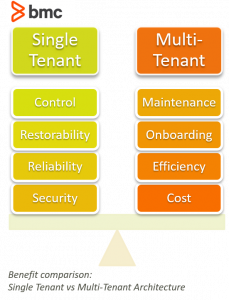One of the single most important parts of an enterprise digital transformation strategy involves finding the right cloud service model that delivers an optimal tradeoff between the risks and opportunities of cloud computing.
Cloud computing comes in various flavors: public cloud, private cloud, and hybrid cloud environment. The architecture of a public cloud service can be shared across multiple tenants, whereas private cloud systems are dedicated for individual business customers.
When you begin learning about the different cloud products available to your organization, you’ll discover two different types of architecture:
- Single tenant architecture
- Multi-tenant architecture
Let’s take a look at both.
Defining single tenant & multi-tenant
In a single tenant cloud environment, the tenant is the client. By design, this type of architecture allows for a single instance or software resource per client to run on the cloud server.
Think of the server environment as a business ecosystem. The best way to describe the nature of single tenant architecture is to imagine each client as its own office building and the server as the street that all of the cloud clients operate from. Each runs its encapsulated operations within their individual office, and offices are lined up side-by-side on the street.
In a multi-tenant environment, the clients are still offices, but this time, they are all located within one high-rise building. Each client operates from its own space within a larger SaaS software product.
This real estate example of single tenant and multi-tenant rings true to its name. In technology, single tenant and multi-tenant platforms offer different benefits and drawbacks. Which is right for your business? Keep reading to find out.

Single tenant cloud architecture: Benefits
First, let’s take a look at the advantages that single tenancy has to offer:
- Security. While no system is 100% secure, single tenant environments more readily allow for increased security as each customer’s data is completely separate from any others. The chance that one customer will accidentally access another’s data (as in a multi-tenant environment) is essentially eliminated.
- Reliability. Single tenant architectures are widely considered to be more reliable because the performance of one customer’s software instance is not affected by the performance of another customer’s.
- Easily restored. In a single tenant environment, you have more control over backups and recovery as one system is backed up to one dedicated part of a SaaS server. On the other hand, in a multi-tenancy environment, this process is much more convoluted to the point that it’s not always available to users.
- Ease of migration. For enterprises that may eventually want to move into a self-hosted environment, the process is less complicated with a single tenancy.
- Full control. In a single tenancy, you have full control over the environment. That means the platform offers much more flexibility in terms of customization. Your added control also applies to upgrades and updates.
Multi-tenant Cloud architecture: Benefits
Some advantages of multi-tenant environments are ideal for certain organizations:
- Lower cost. One financial benefit of a multi-tenant operation is that the per user cost is lower because all resources are shared. If you’re searching for a solution that makes the most financial sense, a multi-tenancy might be it.
- Efficient resource usage. Because all the resources are shared, multi-tenancies operate at maximum resource usage, which makes for optimum efficiency. The system is a constantly moving environment where resources are being simultaneously accessed.
- Ease of set up and onboarding. SaaS platforms offering multi-tenant environments are usually sticklers for providing top-notch customer service. That’s because they have a high volume of customers and need to ensure each has a good experience. The multi-tenant environment is largely the same for each customer, with some optional configurations, making it easier for multi-tenant SaaS companies to perfect the onboarding process and optimize it for ease of use.
- Maintenance. Updates applied to the system affect all customers and, as such, system upgrades and update maintenance are usually handled by the SaaS company, not the individual customer. Because of this, multi-tenancies usually require less maintenance.
Difference between Multi-Tenancy and Multi-Enterprise
It’s worth noting the distinction between multi-tenancy and multi-enterprise. They are two very different concepts, yet easy to confuse.
- Multi-enterprise, also known as multiple-enterprise business networks, are B2B ecosystems that enable two or more parties to collaborate on an activity. According to Gartner, these processes aren’t commonly seen as they focus on “complex relationships or business processes” but they always underscore a “shared objective, shared risk, shared reward and/or shared investment.”
- A multi-tenant environment refers to a vendor related term describing how a software solution is managed.
Choosing between single & multi-tenant cloud architecture
The choice between single and multi-tenant cloud architecture comes down to the business and technical goals, use cases, challenges and opportunities facing the organization. In the table below we summarize various aspects of dedicated cloud architecture systems and public cloud models with multi-tenant architecture characteristics to help your decision:
| Infrastructure | Multi-Tenant Architecture | Single-Tenant Architecture |
| Business size | Small to midsize business firms, 10-250 users across multiple locations | Midsize to large enterprises with a global user base, 100-unlimited users |
| Value propositions | Low cost Rapid provisioning and deployment Off-the-shelf solutions Standard compliance Highly scalable | High performance Strong security and compliance Managed utilization and performance. Speciality hardware and configuration environments High availability and disaster recovery Highly controlled environments |
| Use cases | Resource-intensive IT workloads with low requirements on security and performance Unpredictable and dynamic peak resource utilization. Low in-house IT expertise | Mission-critical IT workloads and sensitive business information storage Predictable workloads Strong governance, control, compliance and audit requirements. |
| Hardware | Logically differentiated between users | Dedicated physical resources |
| Scale | Cloud bursting capability Resource pooling | Fixed resources for predictable workload requirements |
| Security | Standardized security controls | Highly secured cloud environments |
| Compliance | Standardized compliance measures | Dedicated configurations, hardware and security layers. Industry-specific compliance. High visibility and control to enforce governance, audits and control measures. |
| Customizations | Standardized off-the-shelf solution | Highly customizable |
| Cost | Low-cost solution | Expensive with high Total Cost of Ownership |
| Maintenance | Managed by the cloud vendor | Users share management and maintenance responsibilities. |
| Utilization | Optimized for a wide pool of customers Easy to add users and maintain high resource utilization | Limited optimized — planned for long term future projections. Organizations may enforce specific governance controls that may impact ease of use for end-users in favor of security and compliance |
Customers operating a SaaS program in a single tenant environment usually do so to safeguard financial applications and data, or other privileged information, making it less vulnerable to hacker attacks. But is this approach viable? As more and more businesses switch from a private to public cloud ecosystem, it remains to be seen.
Multi-tenancy is popular but it’s not without its limitations. Before deciding whether single tenancy or multi-tenancy is the right choice for your enterprise cloud needs, there are important considerations that need to be made.







